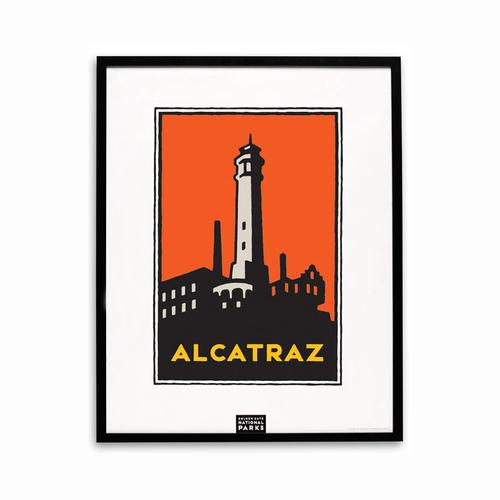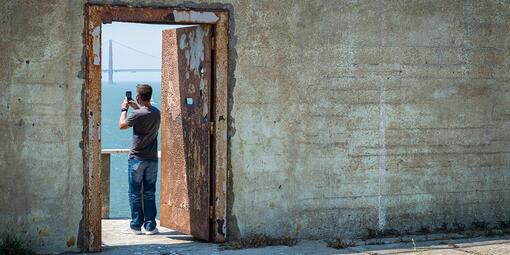Located 1.5 miles off the coast of San Francisco, Alcatraz Island encompasses a total of 22 acres in the center of San Francisco Bay. Opened to the public in fall 1973, Alcatraz is one of America's most popular national park sites and currently welcomes more than 1.4 million visitors each year.
Historical Timeline:
1775: Spanish explorer Lt. Juan Manuel de Ayala maps San Francisco Bay and names the island "La Isla de los Alcatraces" (The Island of the Pelicans). With no vegetation or habitation, Alcatraz was little more than a desolate rocky islet occupied by the occasional swarm of birds.
1850: A joint Army and Navy commission recommends a Triangle of Defense to guard San Francisco Bay. President Millard Fillmore signs an Executive Order reserving lands around San Francisco Bay, including Alcatraz, for "public purposes."
1854: The Alcatraz lighthouse begins service as the first lighthouse on the Pacific Coast.
1857: With the completion of the Guard House, the island serves as a military prison from 1857-1933.
1859: Capt. Joseph Stewart and 86 men of Company H, Third U.S. Artillery, take command of Alcatraz.
1863: The J.M. Chapman, a Confederate privateer ship, is seized and its crew arrested and imprisoned on Alcatraz. Lower Prison, a temporary wooden structure, is built. Soon other prison structures are added on the island.
1865: Alcatraz troops are sent to San Francisco to preserve peace and prevent rioting after President Abraham Lincoln's assassination. Alcatraz cannons fire the official mourning for the dead president.
1870: Major George Mendell designs plans for earthwork defenses on Alcatraz.
1895: Nineteen members of the Hopi Tribe from Arizona are imprisoned on Alcatraz for resisting the policy of forced education of their children and land allotment programs contrary to their Native American beliefs.
1898: Spanish-American War results in prison overcrowding at Alcatraz.
1900: Upper Prison (Alcatraz's third prison) is built on the Parade Ground.
1907: Alcatraz is designated as the "Pacific Branch, U.S. Military Prison."
1912: The new Cellhouse (Alcatraz's fourth prison), built with convict labor, is completed and prisoners move in. At the time the Alcatraz Cellhouse was the largest concrete structure in the world.
1915: Alcatraz is renamed the "United States, Disciplinary Barracks."
1933: Alcatraz is transferred to the Federal Bureau of Prisons; 32 "hard-case" military prisoners remain on the island as the former military detention center becomes America's first maximum-security civilian penitentiary. This "prison system's prison" was specifically designed to house the troublemakers that other federal prisons could not successfully detain.
1934: Alcatraz begins its era as the nation's toughest and most feared federal penitentiary, housing the "worst of the worst" American criminals, among them AI Capone, George "Machine Gun" Kelly, and Robert "Birdman of Alcatraz" Stroud. Prisoners arrived on Alcatraz in handcuffs and ankle shackles. Daily life on Alcatraz was harsh, and prisoners were given only four rights: medical attention, shelter, food and clothing; recreational activities and family visits had to be earned through hard work. Punishments for bad behavior included hard labor and lock-downs in solitary confinement, restricted to bread and water. There were a total of 14 escape attempts by 34 prisoners during its 29 years as a federal penitentiary.
1963: Due to high costs and deteriorating infrastructure, Alcatraz is permanently closed by Attorney General Robert Kennedy and the remaining prisoners are transferred to the new maximum security federal penitentiary in Marion, Ill.
1969-1971: Mohawk tribal leader Richard Oakes leads the occupation of Alcatraz by the "Indians of All Tribes," which at its height numbered more than 400 members. The group hoped to establish an American Indian cultural center on Alcatraz, but when Oakes left the Island due to the tragic death of his stepdaughter, public interest in the occupation waned and order among those remaining on the island began to deteriorate. After 19 months, federal marshals moved in and forcibly removed the few remaining occupiers in June, 1971. The Alcatraz Occupation is recognized as a milestone in American Indian history, and each year, Indians of all tribes return to Alcatraz on Columbus Day and Thanksgiving to hold a Sunrise Ceremony for Indigenous Peoples and commemorate the longest Native American occupation in U.S. history.
1972: Alcatraz becomes a national recreation area under the management of the National Park Service. It opens as a national park attraction in the fall of 1973.
1976: Alcatraz is named to the National Register of Historic Places.
1986: Alcatraz receives designation as a National Historic Landmark.
2013: Alcatraz welcomes more than 1.4 million visitors annually, making it one of the National Park Service's most popular attractions.
The Modern Visitor Experience:
- The award-winning Alcatraz "Doing Time" Digital Audio Tour incorporates interviews with formerly incarcerated people, correctional officers and family members, along with first-person dialogue and state-of-the-art sound effects. The tour is included with every Alcatraz ticket, and is available in braille and 11 languages: English, Dutch, French, German, Italian, Spanish, Japanese, Mandarin, Portuguese, Korean, and Russian.
- Archival museum collections spanning the history of Alcatraz from its time as a military fortress through its notoriety as America's most infamous Federal penitentiary are on exhibit. Highlights include restored cell furnishings, actual prisoner artifacts, and historic artwork and photographs depicting daily life on The Rock.
- The Alcatraz Cell house Museum Store features exhibits of many of the historic artifacts from the Federal penitentiary years. Items include the actual implements used by inmates during the 1962 break out made famous in the movie Escape from Afcatraz; authentic inmate handcuffs and shackles; and correctional of ficer badges and blackjacks. Complementing the artifacts, the Parks Conservancy offers a series of replicas based on these historic items as part of the unique Alcatraz product line.
- On any given day, the Alcatraz Author Program features historians, formerly incarecerated, correctional officers, naturalists or other special guests who have written about Alcatraz.
- Exterior exhibits are installed across the Island, providing visitors with in-depth information on The Rock's history, architecture, wildlife, and landscape as they take in the world-class San Francisco views.
- In its commitment to protect the natural resources of the Island, staff and volunteers ensure ongoing restoration and conservation of the island ecosystem, including habitat protection for the more than 20,000 sea birds who nest on the island each season.
- The Alcatraz Historic Gardens, a striking historic landscape with some plants originally planted in the 1800s, have been lovingly restored after nearly 100 years of decline. The Alcatraz Historic Gardens Project is an ongoing Parks Conservancy-supported effort to restore, preserve and maintain the gardens created by those who lived on the island during its military and federal prison eras in order to interpret their history, horticulture and cultural significance for today's visitors.



